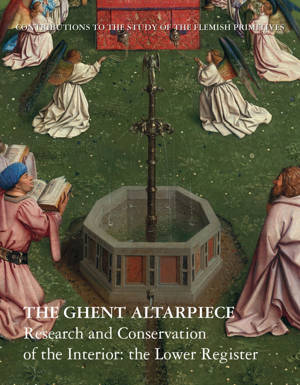
- Afhalen na 1 uur in een winkel met voorraad
- Gratis thuislevering in België vanaf € 30
- Ruim aanbod met 7 miljoen producten
- Afhalen na 1 uur in een winkel met voorraad
- Gratis thuislevering in België vanaf € 30
- Ruim aanbod met 7 miljoen producten
Zoeken
The Ghent Altarpiece
Research and Conservation of the Interior: The Lower Register
Griet Steyaert
Hardcover | Engels
€ 58,00
+ 116 punten
Omschrijving
The Ghent Altarpiece by Hubert and Jan van Eyck has always attracted both admiration and curiosity. Following the conservation of the paintings of the closed polyptych, it was the turn of those from the lower register of the open altarpiece - including the famous Adoration of the Lamb - to undergo a major research and conservation campaign by the Royal Institute for Cultural Heritage (KIK-IRPA, Brussels) between 2016 and 2020. The findings reflect those for the closed altarpiece: large areas of the panels were covered with overpaints, the vast majority dating from the 16th century. Their removal allows the Van Eycks brothers' paintings to be truly appreciated again. The three years that the conservators spent working on the panels enabled them to examine the paintings down to the smallest details. Interdisciplinary collaboration with laboratory scientists, art historians and imaging experts led to a series of discoveries - some anticipated in light of earlier research, others unexpected. The authenticity of the quatrain stating that Hubert had begun the work, that his brother Jan completed it and that it was presented in 1432, has been firmly established for some years now. New hypotheses are proposed here regarding the division of labour between the two Van Eyck brothers. The contribution of Hubert, who died in 1426, can finally be seen more clearly and is far from negligible. But the removal of overpaints has revealed non-Eyckian interventions too...
Specificaties
Betrokkenen
- Auteur(s):
- Uitgeverij:
Inhoud
- Aantal bladzijden:
- 300
- Taal:
- Engels
Eigenschappen
- Productcode (EAN):
- 9782930054414
- Verschijningsdatum:
- 15/10/2021
- Uitvoering:
- Hardcover
- Formaat:
- Genaaid
- Afmetingen:
- 224 mm x 290 mm
- Gewicht:
- 1270 g

Alleen bij Standaard Boekhandel
+ 116 punten op je klantenkaart van Standaard Boekhandel
Beoordelingen
We publiceren alleen reviews die voldoen aan de voorwaarden voor reviews. Bekijk onze voorwaarden voor reviews.











